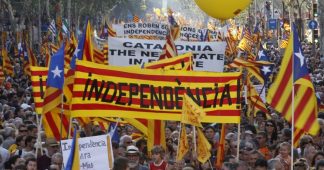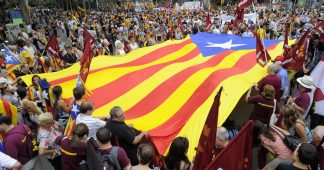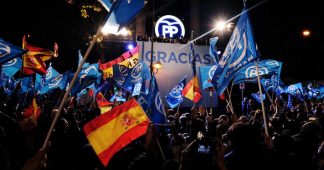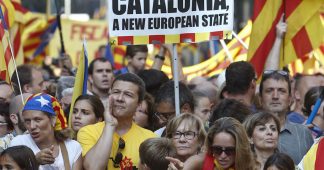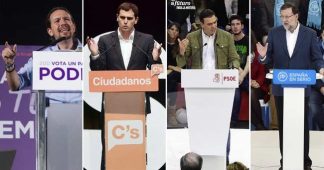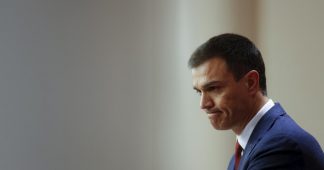By Dick Nichols
Saturday, September 2, 2017
Half-a-million people marched in the Catalan capital of Barcelona on August 26 to express the profound desire in Catalan society to stay tolerant, open and un-militarised in the face of the August 17-18 terror attacks on Barcelona’s Rambla and in the seaside town of Cambrils.
This was partly because the attacks — claimed by Islamic State and causing 15 deaths and up to 130 wounded — coincided with the tensest moments to date in the fight between the Catalan and Spanish governments over the planned October 1 referendum on Catalan independence.
The right-wing People’s Party (PP) government of Spanish Prime Minister Mariano Rajoy is determined that the plebiscite it calls unconstitutional will not take place. The pro-independence Catalan government of Premier Carles Puigdemont, basing itself on the 70% to 80% support in Catalonia for the right to self-determination, is determined it will.
The aims of the march, called jointly by the Catalan government and Barcelona Council, were to: reject terrorism (through the slogan “I’m Not Afraid”); express solidarity with the families of victims; assert Barcelona’s determination to retain its vibrant, cosmopolitan and welcoming character; mark community appreciation of the rapid response to the crisis of Catalan police, and emergency service and health workers; and reaffirm the values of tolerance and solidarity, especially in relation to Catalonia’s Muslim communities.
However, no mass anti-terrorism demonstration in present-day Catalonia can be confined to motherhood positions on those themes — as events soon confirmed.
Competing approaches
An immediate reflection of the political complexity involved came the day after Barcelona Mayor Ada Colau and Puigdemont announced the march: the left-nationalist People’s Unity List (CUP), part of the pro-independence bloc in the Catalan parliament, said it would not take part if representatives of the Spanish state (led by Rajoy and King Philip) were present.
This stance reflected the widespread feeling in the Catalan left and social movements — which earlier this year produced the world’s biggest-ever march in support of refugees — that they had to express their own position on the terror attacks.
The upshot was the manifesto After the August 17 Tragedy: Peace, Solidarity and Coexistence in Diversity, which was supported by 170 social, political and cultural organisations. These included major forces like the Catalan National Congress, the Confederation of Neighbourhood Associations of Catalonia and the language and culture association Omnium Cultural.
It stated: “We protest to denounce the hypocrisy of political leaders and representatives, the Spanish government and the monarchy.
“Those who, with their policies, promote wars and foster armed conflicts by selling arms to countries like Saudi Arabia and Qatar [as Spain does], as well as imposing repressive anti-terrorist policies that only worsen the spiral of violence.
“Those who breach their commitment to give asylum, as the European Union member states do. Also those that promote hatred, racism, xenophobia and Islamophobia, with the worrying collaboration of much of the media.
“Those who stop and search our neighbours on the street because of their skin colour and imprison them at the Centres for the Internment of Foreigners.”
If adopted universally, such a position would have turned the march into a mass protest against the foreign policy of the Spanish state and the PP government.
Three marches in one
To accommodate the competing pressures on them, march organisers were forced to announce a change to its format: instead of being headed in the usual style by dignitaries holding the lead banner, this time the leading group would be made up of emergency service and health workers, firefighters and police. The notables were demoted to a second contingent.
This arrangement gave pride of place to those whom ordinary Catalonia felt were the heroes of August 17-18, maintained an acceptable spot for the dignitaries and also allowed the supporters of the peace and solidarity manifesto to form a third contingent. Its participants were encouraged to wear sea blue, the same colour as the refugee rights demonstration earlier in the year.
The result was August 26’s three-marches-in-one: first the emergency service workers whom everyone cheered and hugged; then the dignitaries including the king and Rajoy (loudly booed and whistled); then the “blue contingent” behind an enormous banner that read: “Your policies, our dead.”
Behind these three came the mass of “ordinary” Barcelona citizens, half-a-million according to the municipal police. This was a huge turnout, given that in late August a large part of the city’s people were still out of town on summer holidays.
The size of the crowd ensured that the supply of 70,000 red, yellow and white roses (colours of the city), donated by the Guild of Florists of Catalonia, fell well short of demand.
The multilingual placards distributed by the activists of the blue contingent then provided, along with some Catalan independence flags, the main decor for the bulk of the march. Those watching could read in Catalan, Spanish and English messages such as “Mariano, people who want peace don’t deal in arms” and “Imagine a country that doesn’t sell weapons”.
After the march arrived at its destination in central Plaza Catalonia, it ended with a simple ceremony. Actress Rosa Maria Sarda first read the demonstration’s declaration with Miriam Hatibi, spokesperson for the Ibn Batutta Foundation (dedicated to winning full citizenship for migrants).
It said: “When the terrorists strike, instead of dividing us they find us more united than ever in freedom and democracy and from the diversity of our cultures and beliefs …
“We are not alone: many millions of us have rejected violence and defend coexistence in Manchester and Nairobi, in Paris and Baghdad, in Brussels and New York, in Berlin and Kabul.”
Sarda then quoted lines from Spanish poet Federico Garcia Lorca’s celebration of Barcelona’s Rambla: “The street where the four seasons of the year live together at the same time, the only street in the world that I would wish never ended.”
A week of demonstrations
The march was the final moment in a week of demonstrations and other actions across Catalonia. These protests showed the determination of the bulk of Catalan society to resist Islamophobic and repressive reactions to the tragedy of August 17-18.
The one attempt by the far-right to hold a protest (in Barcelona on the day after the Rambla attack) failed miserably. It was outnumbered by an anti-fascist counter-mobilisation — its handful of participants had to be escorted away under police protection.
On August 18, the first demonstration after the attack drew 100,000 to central Plaza Catalonia for the observance of a minute’s silence. The chant that was to become the theme of the huge August 26 march (“We Aren’t Afraid”) started up spontaneously as this act was ending. Many of those in attendance, up to 30,000, then moved to the Rambla, where they set up make-shift shrines to the victims of the attack.
The next demonstration in Barcelona was “Muslims against terrorism”, which drew 2500. It featured a manifesto demanding Catalonia’s institutions take the vulnerable situation of young men in Muslim and Arabic-speaking communities much more seriously.
The terrorist group responsible for the Barcelona-Cambrils attacks was largely made up of young men who had been brought up in Catalonia, had appeared “integrated”, but were still seduced by the message of an imam secretly recruiting for Islamic State.
Rally organiser Mohammed Chaib said: “We all have to make a self-criticism. It is not normal that some young people who have grown up in Catalonia should end up turning against the country. Something isn’t working.”
Probably the most powerful demonstration, however, was one of the smallest. On August 24, 700 people in the industrial town of Rubi gathered at the town hall to remember two locals who had died in the Barcelona attack, including a three-year-old boy.
At the ceremony his father, who had previously said that he understood the agony the families of the terrorists must be going through, embraced the local imam as a simple act of human solidarity.
The imam broke down in tears, and was comforted by the father: the photo of this moment immediately went viral in Catalonia, with people even printing it off to pin on the improvised shrines in the Barcelona Rambla and elsewhere.
The Madrid media
It was to be expected that the booing of the king and Rajoy on August 26 would severely irritate the establishment media in Madrid.
However, in the context of rising Spain-Catalonia tensions, its commentators even accused the Catalan government of, in the words of Jose Oneto in Republica, “turning the demonstration into an act of force in favour of the independence movement and as a general rehearsal for the Catalan National Day of September 11, opening door in the campaign for the October 1 referendum”.
At the same time, Catalonia (“the autonomous regions where the Islamic community shows greatest signs of radicalism” according to the August 18 El Mundo) and the Catalan government’s obsession with independence allegedly undermines the all-Spanish anti-terrorist effort. The Catalan authorities are accused of turning a blind eye to radical Islamic immigration so long as it votes the right way in Catalonia.
* Dick Nichols is Green Left Weekly European correspondent, based in Barcelona. A longer version of this article will soon appear at Links International Journal of Socialist Renewal.
